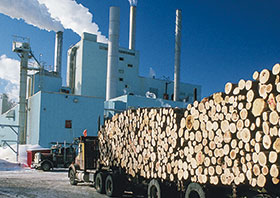

Harsh process conditions have historically prevented the use of mechanical consistency transmitters in Kamyr continuous digester blow lines. The mechanical design of existing transmitters has not been robust enough to survive the unusually high flow rates enforced with uncooked chips and knots, high chemical concentrations with pH exceeding 13, temperatures above flash point as well as rocks and debris.
Traditionally the operators have made some estimation of the consistency by monitoring the current of the scraper motor, or by measuring the differential pressure at the outlet device at the bottom of the digester. While neither measurement has been adequate for the control of cold blow flow, they were used as an indication.
The KC/3 for severe process conditions
ABB Oy, KPM has developed a new consistency transmitter which finally meets the challenge. This blade type transmitter, called KC/3, is made of a solid titanium body without any seals, O-rings or gaskets. This leak-proof design can safely be installed in very severe process conditions, including blow lines and blow tank outlets.
Stora Enso in Oulu, Finland installed a KC/3 in its pulp mill blow line. The installation was straightforward as all required hardware was included in delivery. The special protective deflectors designed for blow line applications with detailed installation and welding instructions are part of the delivery.
The benefits
Occasionally the production rate can drop due to disturbances in flow internal to the digester e.g. chip column movement can stop because of channelling in the washing zone. This will immediately cause serious quality problems. Chips are over cooked, strength properties suffer, and, of course, production rate drops as a result of lower blow consistency.
Having a reliable consistency measurement in the blow line, the operator is warned immediately about a disturbance and can react swiftly. He could, for example, temporarily reduce the flow in washing circulation or change the locations of the wash liquid feed.
During normal run, the differential pressure at the bottom, scraper current and consistency track each other fairly well. The pressure difference does not see the consistency drop but on the contrary indicates higher numbers. Shortly thereafter, the scraper current of the diffusion washer proves that consistency really has dropped. In addition to prompt and reliable information of process disturbances, the production rate calculation becomes more accurate.
This helps to track and control the grade changes to the screening and washing stages. Reliable and exceptionally strong the KC/3 when installed in a blow line provides an important measurement to assist the operators with digester control.
For more information contact Stuart Brown, UIC Instrumentation, +27 (0)31 468 2561, [email protected], www.uic.co.za
| Tel: | +27 31 468 2561 |
| Email: | [email protected] |
| www: | |
| Articles: | More information and articles about UIC Control & Automation |

© Technews Publishing (Pty) Ltd | All Rights Reserved